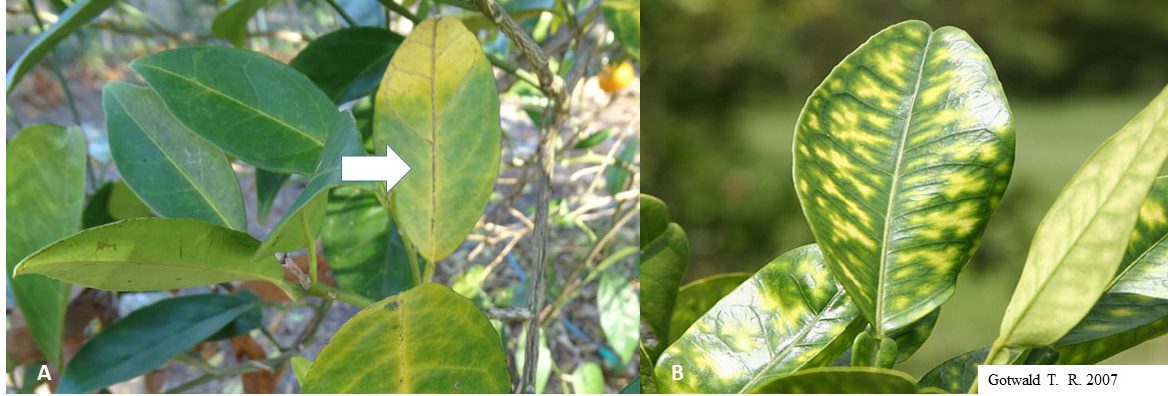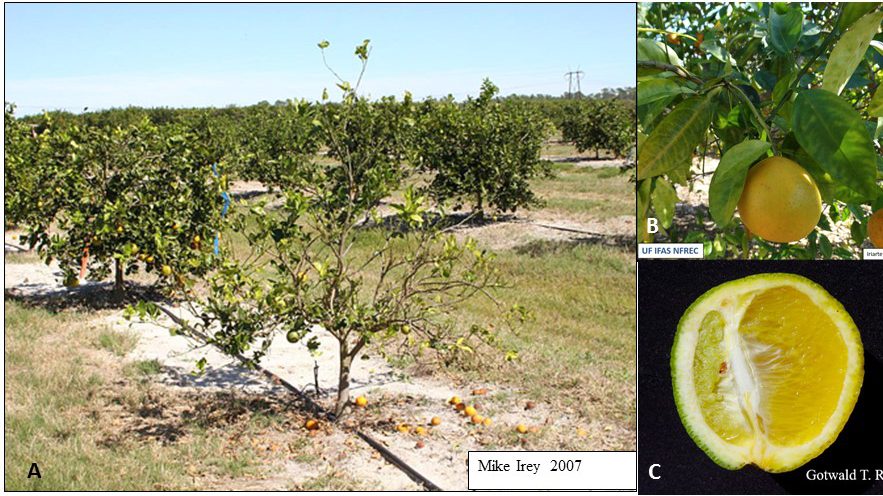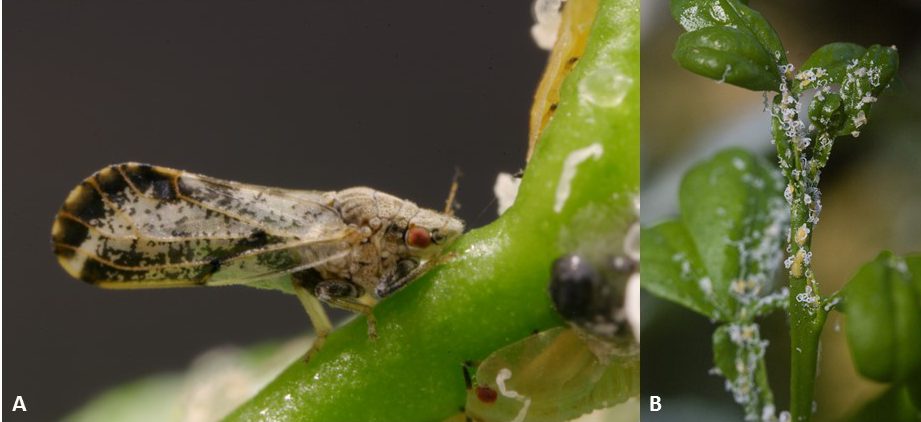F. Iriarte, X. Martini, M. Paret, UF/IFAS North Florida Research and Education Center (NFREC) Quincy, and E. Lovestrand, UF/IFAS Franklin Co. Extension
Huanglongbing (HLB), also known as Yellow Shoot or Citrus Greening is a devastating disease of citrus worldwide. The disease is caused by a bacteria named Candidatus Liberibacter asiaticus. This bacterium is transmitted by the Asian citrus psyllid (ACP), which was discovered for first time in the US in Palm Beach County in June 1998. The first cases of HLB were discovered in south Miami-Dade County-FL in August 2005. Since then, the disease and its vector have affected most of Florida’s citrus-producing areas leading to a dramatic decline in Florida’s citrus industry. The Florida Panhandle is one of the last regions in Florida where HLB and ACP had not established; however, the very first HLB case in North Florida was discovered December 6, 2016 in Carrabelle, Florida. Even though psyllids were not found in Carrabelle, some were captured in Bay and Gadsden counties in 2016, therefore it is likely that other citrus trees in the area may be also infected.
Symptoms

Figure 1. Leaves of a HLB infected Citrus tree. Note the asymmetrical chlorosis on the leaves across the midvein.
Affected leaves develop a pattern of yellow and green areas giving a “blotchy mottled” appearance. The patterns are asymmetrical on the two halves of the leaf and will be visible on both sides of the leaf (Figure 1). Leaves can become thicker, with veins enlarged and corky in appearance (Figure 2A) and zinc-like deficiency symptoms may develop (Figure 2B). Zinc deficiency typically appears on new foliage throughout the tree, in contrast to early HLB symptoms, which are restricted to a single or a few shoots. On severely infected trees, leaf drop, twig dieback and extensive fruit drop occurs (Figure 3A). Fruit may be small, poorly colored, lopsided and may taste medicinal or sour (Figure 3B and 3C).
Epidemiology

Figure 2 Citrus tree showing (A) vein corking symptom, (B) “zinc-pattern-deficiency” interveinal chlorosis symptoms (picture by time Gotwald).

Fig. 3. (A) 2 to 3 year old sweet orange tree in south Florida with HLB-induced fruit drop, dieback, and defoliation leading to thin canopy (picture by Mike Irey). (B) Lopsided citrus fruit (C) Asymmetrical “lopsided” sweet orange fruit (picture by Tim Gotwald).
The psyllid vector feeds on a wide variety of host plants including the common Orange Jasmine. The bacteria that causes greening can also be transmitted by grafting, and by dodder (parasitic plant), but not seed. The pathogen does not spread by casual contamination of personnel and tools or by wind and rain. It severely affects most sweet oranges, mandarins, and mandarin hybrids, as well as some citrus relatives.
Vector
The Asian citrus psyllid is a small insect about 1/8 inches long at the adult stage, with black coloration at the end of the wing. Adults jump when approached and sit in a vertical position with abdomen up in the air. Nymphs have a flat yellow body and produce distinctive white honeydew. They also distort the young leaves when they feed on them. Nymphs and adults are found on the new emerging leaves; therefore, regular inspection of these new leaves is a good way to assess the presence of psyllids.

Fig. 4 (A) Asian citrus psyllid adult. (B) Asian citrus psyllid nymphs; note the white honeydew and the leaf distortion.
Management
University of Florida Citrus Research and Education Center faculty recommend scouting for the disease and for the Asian citrus psyllid for early detection. Other management actions include removal of HLB trees plus applying herbicides to the stump; propagation of clean nursery stock; psyllid control with insecticide applications; removal of potential inoculum sources, and removal of alternate hosts such as orange jasmine and box orange from around a commercial citrus grove.
The entire state of Florida is under quarantine with specific regulations and inspection procedures regarding the propagation, shipping, and transport of citrus trees and fruit. FDACS DPI officials stated that while there are currently no regulations for moving dooryard citrus within Florida (except in citrus black spot quarantine areas), having your homegrown citrus inspected by an FDACS DPI inspector before moving it within Florida is strongly recommended.
Considering the situation in North Florida, where citrus greening is not well established, UF scientists recommend removal of any infected tree to avoid further spread of the disease to nearby healthy plants. Citrus growers in the area should be familiar with the symptoms of Huanglongbing and be able to recognize the Asian citrus psyllid. Growers should monitor their plants routinely, as early detection will slow down further spread of the disease with removal of infected trees and control of the insect vector.
—
For more information, watch the following video or use the links to the following websites:
[youtube https://www.youtube.com/watch?v=DBl1tlDAi3M?rel=0]
FDACS Citrus Greening Disease Information web page
UF/IFAS Citrus Greening publications directory
- Citrus Greening (HLB) Update for North Florida and Georgia - December 17, 2021
- Hemp Diseases in North Florida - March 19, 2021
- NFREC Plant Disease Diagnostic Clinic in Quincy Reopens with Limited Hours - April 17, 2020
